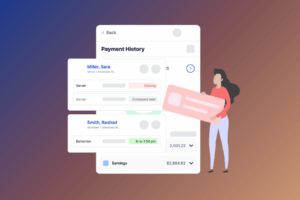Share
The tennis industry is experiencing remarkable growth, with the global market expanding from approximately $1.5 billion in 2024 to a projected $2.3 billion by 2033—representing a steady compound annual growth rate of 5%. This expansion creates significant opportunities for club owners and operators who understand how to optimize their revenue streams and operational efficiency.
Recent years brought unprecedented demand to tennis, with over five million new players joining the sport in just four years. However, converting this growing interest into sustainable profits requires strategic approaches to membership management, facility utilization, staffing, and technology integration that many clubs struggle to implement effectively.
Building a profitable tennis operation depends on understanding and optimizing multiple revenue streams while managing operational costs that can consume up to 40% of total revenue. From membership fees and court rentals to coaching services and ancillary offerings, successful clubs master the art of revenue diversification while maintaining exceptional member experiences that drive long-term loyalty and growth.
Understanding Tennis Club Revenue Fundamentals
Building sustainable profits begins with comprehending the diverse revenue streams that successful clubs cultivate and optimize to create consistent financial performance.
Primary Revenue Streams Analysis
The key income sources for tennis facilities include membership fees, court rentals, coaching fees, and revenue from hosting tournaments and events. Membership fees typically represent the most significant contributor, providing a stable foundation that supports profitable operations.
Membership Revenue Optimization: Membership fees can indirectly influence profits through secondary spending within the club. Members frequently invest in ancillary services such as private coaching, pro shop purchases, and food and beverage, contributing to additional income streams beyond basic membership dues.
Court Rental Strategy: Court rentals and private lessons offer valuable supplementary income, which can be maximized through strategic scheduling and tiered pricing strategies. Effective court utilization requires balancing member access with revenue-generating activities while avoiding the ceiling that comes with focusing solely on occupancy rates.
Coaching and Instruction Revenue: Private coaching represents a crucial income stream that provides consistent revenue while enhancing member satisfaction and retention. The strategic importance of professional instruction extends beyond direct earnings to membership retention and acquisition, with members who engage in coaching services showing significantly higher loyalty rates.
Revenue Per Player (RPP) Methodology
Moving beyond traditional metrics like court utilization, successful facilities focus on Revenue Per Player (RPP), which provides insights into how much value each player brings through memberships, lessons, events, and retail purchases.
RPP Calculation Framework: This approach shifts focus from surface-level metrics to comprehensive player value assessment. By tracking total revenue generated per player across all touchpoints, clubs can identify high-value members and optimize services to increase overall returns.
Player Segmentation Strategy: Not all members contribute in the same way. Some players participate in weekly lessons providing consistent revenue, while others may use courts occasionally but spend significantly on gear, refreshments, or private events. Understanding these spending patterns enables targeted service development and marketing strategies.
Market Analysis and Positioning
According to industry reports, facilities in urban areas with higher population densities tend to report annual revenues on the higher end due to larger client bases and the ability to charge premium rates for court times and memberships.
Location Impact on Revenue: Clubs in suburban or rural areas might not achieve the highest revenue marks but can still operate profitably by managing costs appropriately and serving their specific market demographics effectively.
Competitive Positioning: Competition can significantly impact financial performance, especially in areas with multiple sports facilities. Clubs must continuously innovate and maintain high standards to stay competitive while differentiating their offerings from alternative recreational activities.
Operational Efficiency and Cost Management
Sustainable profits require systematic attention to operational efficiency and cost management across all aspects of club operations.
Facility Management and Maintenance
Providing quality club management through efficient facility maintenance can be costly, affecting the overall ability to fund operational costs, especially in competitive markets.
Court Maintenance Optimization: The type and quality of courts directly influence both operational costs and revenue potential. Hard courts are the most common and easiest to maintain, while clay courts are more expensive to maintain but may command premium pricing from certain player segments.
Energy Efficiency Implementation: Studies show that energy-efficient upgrades such as LED lighting and optimized HVAC systems can reduce power costs by up to 20%, making these investments essential for sustainable operational savings and improved financial performance.
Preventive Maintenance Strategy: Regular scheduling of maintenance prevents costly emergency repairs while maintaining the facility quality that justifies premium membership pricing and attracts quality members.
Staffing and Payroll Management
Attracting and retaining qualified coaching staff represents a significant challenge that directly impacts both operational costs and revenue generation potential.
Professional Development Investment: Clubs that invest in competitive salaries and continuous professional development typically see a 20% improvement in member retention and operational efficiency, demonstrating the ROI of quality staffing investments.
Payroll Efficiency Solutions: Managing staff payroll efficiently becomes crucial for financial success. Modern clubs benefit from integrated payroll management systems that streamline administrative tasks while ensuring accuracy in compensation calculations. Solutions like comprehensive fitness club automation can eliminate manual payroll processes, saving countless hours previously spent checking and cross-checking staff invoices.
Performance-Based Compensation: Implementing performance-based bonuses averaging 10-15% of annual salaries helps retain skilled trainers while aligning staff incentives with club financial goals.
Technology Integration for Efficiency
Digital platform integration with smart technologies opens opportunities for facilities to engage new members more effectively while optimizing operations through automation and data analytics.
Online Booking and Management: Implementing online booking systems and member management platforms reduces administrative overhead while improving member experience and court utilization rates.
Mobile-First Solutions: Members expect mobile accessibility for court reservations, class registration, and communication, making mobile-friendly platforms essential for competitive positioning and operational efficiency.
Automated Administrative Tasks: Technology that eliminates repetitive manual tasks allows staff to focus on higher-value activities that directly contribute to member satisfaction and revenue generation.
Strategic Revenue Enhancement Techniques
Building sustainable profits requires systematic approaches to revenue enhancement that go beyond traditional membership and court rental income.
Membership Tier Optimization
Implementing multiple membership tiers allows for personalized service and can drive revenue growth by accommodating diverse member needs and financial capabilities.
Tiered Pricing Strategy: By offering flexible plans such as monthly and annual subscriptions, alongside special packages for coaching or tournament entry fees, clubs ensure steady cash flow while catering to varying customer needs. A tiered pricing model might increase overall income by 20% compared to single pricing models.
Member Benefit Enhancement: Including perks such as free guest passes, discounts on private coaching and pro shop goods increases member satisfaction while encouraging additional spending within the club ecosystem.
Seasonal Promotion Programs: Implementing seasonal promotions attracts new members during slower periods, helping maintain steady income flow throughout the year and optimizing seasonal variations in earnings.
Coaching and Training Program Expansion
Expanding coaching and training programs creates significant opportunities for revenue enhancement while improving member engagement and satisfaction.
Specialized Program Development: Offering state-of-the-art facilities paired with high-caliber coaching services can boost revenue by up to 30%. Programs ranging from beginner clinics to advanced training sessions attract wider ranges of players, enhancing both membership and community engagement.
Private and Group Lesson Optimization: Data shows that well-trained coaches can generate up to 20% higher revenue through enhanced player performance and increased membership retention, making coaching program quality essential for financial success.
Youth and Adult Program Balance: Developing comprehensive programs for different age groups and skill levels maximizes facility utilization while creating multiple revenue streams that appeal to diverse market segments.
Event and Tournament Revenue
Tournament and event hosting provides significant opportunities for revenue enhancement beyond regular membership and coaching income.
Tournament Revenue Generation: Seasoned operators note that clubs can boost income through tournaments, events, and merchandise sales. Data shows that facilities hosting well-organized tournaments experience a revenue boost of up to 15% compared to those solely focused on regular membership subscriptions.
Community Event Hosting: Community events and charity tennis days enhance the club’s profile while creating additional revenue opportunities through entry fees, sponsorships, and ancillary sales.
Corporate and Private Event Services: Offering facilities for corporate events, private parties, and special celebrations creates revenue streams that utilize club facilities during typically slower periods.
Membership Management and Retention
Sustainable financial success depends heavily on effective membership management and retention strategies that maximize lifetime member value.
Member Acquisition Strategies
Effective member acquisition requires understanding target demographics and implementing marketing strategies that resonate with potential tennis players.
Digital Marketing Integration: Targeted digital campaigns have proven to boost community engagement by over 40% in similar clubs, making online marketing essential for member acquisition and retention.
Referral Program Implementation: Member referral programs and discounts offer scalable ways to boost budgets by incentivizing existing members to invite friends and family, reducing customer acquisition costs by an estimated 20-30% compared to traditional advertising campaigns.
Trial and Guest Pass Programs: Offering trial memberships and guest passes allows potential members to experience club quality before committing, improving conversion rates while building member confidence in club value.
Retention and Engagement
Member retention directly impacts financial performance by reducing acquisition costs while increasing lifetime member value through continued payments and additional service purchases.
Member Experience Enhancement: Average health clubs see a 28.6% annual attrition rate, making exceptional member experience essential for retention. Tennis facilities must provide superior facilities, services, and community experiences that justify membership costs.
Communication and Community Building: Regular communication through newsletters, social media, and member events helps build community connections that increase member loyalty and reduce churn rates.
Feedback Integration Systems: Implementing regular member feedback collection and acting on suggestions demonstrates responsiveness while identifying improvement opportunities that enhance satisfaction and retention.
Member Analytics and Optimization
Understanding member behavior and preferences enables data-driven decisions that improve both satisfaction and financial outcomes.
Usage Pattern Analysis: Tracking member usage patterns helps identify opportunities for additional service offerings while optimizing facility scheduling and staffing to meet demand effectively.
Lifetime Value Calculation: Understanding member lifetime value helps justify acquisition costs and retention investments while informing pricing strategies and service development decisions.
Segmentation and Personalization: Segmenting members by usage patterns, preferences, and value enables personalized service delivery and targeted marketing that improves satisfaction while increasing revenue per member.
Financial Planning and Performance Measurement
Sustainable success requires comprehensive financial planning and performance measurement systems that track key metrics and inform strategic decisions.
Timeline and Expectations
Industry benchmarks suggest that a profitable tennis operation typically begins to see positive financial returns within 3 to 5 years, contingent upon effective management and strategic business planning.
Initial Investment Recovery: The initial period involves significant capital investment in construction or renovation of facilities, equipment purchases, and marketing efforts to attract members. Understanding these upfront costs helps establish realistic financial timelines.
Break-Even Analysis: Conducting thorough break-even analysis helps determine the sales volume needed to cover all expenses and begin making profit, providing essential guidance for membership pricing and target setting.
Cash Flow Management: Maintaining positive cash flow throughout the startup and growth phases requires careful attention to membership billing cycles, seasonal variations, and operational expense timing.
Key Performance Indicators (KPIs)
Tracking appropriate KPIs provides insights into financial trends and helps identify areas requiring attention or improvement.
Revenue Metrics:
- Average revenue per member
- Court utilization rates
- Coaching revenue per instructor
- Pro shop and ancillary revenue
- Event and tournament income
Cost Management Indicators:
- Operating cost percentage of revenue
- Staff costs as percentage of revenue
- Facility maintenance costs
- Marketing and acquisition costs
Member Satisfaction Metrics:
- Member retention rates
- Net promoter scores
- Usage frequency patterns
- Satisfaction survey results
Financial Risk Management
Financial risks must be continuously assessed and managed to maintain sustainable operations and ensure long-term success.
Seasonal Revenue Fluctuations: Tennis being largely an outdoor sport means revenues can be affected by unfavorable weather conditions, requiring financial planning that accounts for seasonal variations and weather-related impacts.
Economic Sensitivity: Economic downturns usually translate to cuts in expenses deemed non-essential, such as recreational activities, leading to downturns in memberships and revenues. Maintaining flexible pricing and service options helps weather economic challenges.
Competition and Market Changes: Changes in local competition, demographic shifts, and recreational preferences can impact membership and revenue, requiring ongoing market analysis and adaptive strategies.
Technology and Innovation for Success
Modern tennis operations increasingly depend on technology integration that improves operational efficiency while enhancing member experience and satisfaction.
Club Management Software Solutions
Comprehensive club management software provides integrated solutions for scheduling, billing, member management, and communication that improve both efficiency and financial performance.
Integrated Operational Management: Modern management software streamlines court reservations, member registration, coaching schedules, and financial management in unified platforms that reduce administrative overhead while improving service quality.
Automated Billing and Payment Processing: Automated billing systems reduce administrative costs while improving cash flow through proactive payment processing and automatic payment updates that prevent membership cancellations due to payment failures.
Member Self-Service Capabilities: Online platforms that allow members to book courts, register for programs, and manage their accounts reduce staff workload while providing 24/7 service access that improves member satisfaction.
Data Analytics and Performance Optimization
Data analytics capabilities provide insights that inform strategic decisions and optimize both revenue generation and cost management.
Utilization Analytics: Detailed analysis of court usage patterns, peak demand times, and member preferences enables optimized scheduling and pricing strategies that maximize revenue from available facilities.
Member Behavior Insights: Understanding member engagement patterns, service preferences, and spending behaviors enables targeted service development and marketing that increases revenue per member.
Predictive Analytics: Advanced analytics can predict member churn risk, identify upselling opportunities, and forecast demand patterns that inform staffing and inventory decisions.
Digital Marketing and Communication
Digital platforms provide cost-effective marketing and communication channels that improve member acquisition and retention while reducing traditional marketing costs.
Social Media Engagement: Strategic social media presence builds community engagement while providing platforms for member success stories, event promotion, and new member acquisition.
Email Marketing Automation: Automated email campaigns for member communication, class reminders, and promotional offers improve engagement while reducing staff communication workload.
Online Reputation Management: Monitoring and managing online reviews and reputation helps maintain positive community perception while addressing member concerns proactively.
Future Trends and Opportunities
The tennis industry will continue evolving as market trends, technology advances, and member expectations change, requiring adaptive strategies and forward-thinking approaches.
Market Growth and Expansion
The global tennis market’s projected growth to $2.3 billion by 2033 creates opportunities for both new club development and existing facility expansion.
Demographic Trends: Growing health consciousness and fitness awareness drive increased participation in tennis and other racquet sports, creating expanding market opportunities for well-positioned clubs.
Urban Development: Increasing urbanization creates both opportunities and challenges, with higher population density providing larger potential member bases but also increasing real estate costs and competition.
Multi-Sport Integration: Many facilities are incorporating pickleball and other racquet sports to maximize facility utilization and appeal to broader member bases, creating additional revenue streams.
Technology Evolution
Advancing technology will continue creating new opportunities for operational efficiency and member experience enhancement.
Smart Court Technology: Smart courts with sensors and cameras for performance analysis are becoming popular, enhancing training effectiveness while creating premium service offerings that command higher pricing.
AI and Automation: Artificial intelligence applications for member engagement, schedule optimization, and predictive analytics will provide competitive advantages for clubs that embrace these technologies effectively.
Virtual and Augmented Reality: VR and AR technologies may create new training and entertainment opportunities that differentiate clubs while generating additional revenue streams.
Sustainability and Environmental Considerations
Environmental sustainability concerns create both challenges and opportunities for tennis operations.
Green Technology Investment: Demand for environmental adaptation and energy-efficient buildings may raise implementation costs, but also create opportunities for operational savings and premium positioning.
Sustainable Operations: Clubs that implement sustainable practices may appeal to environmentally conscious members while reducing long-term operational costs through efficiency improvements.
Community Environmental Leadership: Positioning clubs as environmental leaders in their communities can enhance reputation and member pride while potentially accessing grants or incentives for sustainable improvements.
Implementation Strategies for Enhanced Performance
Successfully implementing revenue enhancement strategies requires systematic approaches that address both immediate opportunities and long-term sustainability.
Strategic Planning and Goal Setting
Effective improvement begins with comprehensive strategic planning that aligns all club activities with financial objectives.
Financial Goal Establishment: Setting specific, measurable targets provides direction for all operational decisions and helps prioritize investments and improvements.
Competitive Analysis: Understanding local competition and market positioning helps identify differentiation opportunities and optimal pricing strategies that maximize revenue potential.
Member Need Assessment: Regular assessment of member needs and preferences ensures that club improvements and investments align with member value perceptions and willingness to pay.
Phased Implementation Approach
Implementing improvements in phases allows for testing and refinement while managing risk and resource allocation.
Quick Win Identification: Identifying and implementing quick wins such as pricing optimization, cost reduction opportunities, and technology upgrades provides immediate improvements while building momentum for larger changes.
Long-Term Investment Planning: Planning major facility improvements, technology upgrades, and program expansions ensures that long-term investments align with strategic goals and market opportunities.
Performance Monitoring: Regular monitoring of implementation progress and financial results enables course corrections and optimization of strategies based on actual performance data.
Staff Training and Development
Successful enhancement requires staff who understand and support financial objectives while delivering exceptional member experiences.
Financial Awareness Training: Training staff to understand how their roles contribute to club success helps align individual performance with organizational financial goals.
Customer Service Excellence: Investing in customer service training improves member satisfaction and retention while reducing costly member acquisition needs.
Technology Proficiency: Ensuring staff proficiency with club management systems and digital tools maximizes technology investments while improving operational efficiency.
Conclusion
Tennis club profitability represents both a significant opportunity and a complex challenge in today’s growing recreational sports market. With the global tennis market projected to reach $2.3 billion by 2033, clubs that master the fundamentals of revenue optimization, cost management, and member experience will be positioned for exceptional success.
The key to sustainable financial performance lies in understanding and optimizing multiple revenue streams while maintaining operational efficiency through technology integration and strategic cost management. From implementing sophisticated membership tier strategies to leveraging data analytics for informed decision-making, successful clubs treat financial success as a comprehensive business strategy rather than a simple accounting exercise.
Modern tennis facilities must embrace technology solutions that streamline operations while enhancing member experiences. The integration of club management software, automated billing systems, and data analytics platforms provides the operational foundation necessary for sustainable growth in competitive markets.
Looking forward, success will increasingly depend on adaptability and innovation as market conditions, member expectations, and technology capabilities continue evolving. Clubs that invest in comprehensive strategies while maintaining focus on member satisfaction and community engagement will thrive in the expanding tennis market, creating value for both owners and members in sustainable, profitable operations.
Related articles

SECURE 2.0 Act: What Business Leaders Need to Know

It’s Time for Your Year-End Audit: 7 Mistakes to Avoid

What Makes Netchex Different from Other Payroll Platforms?

